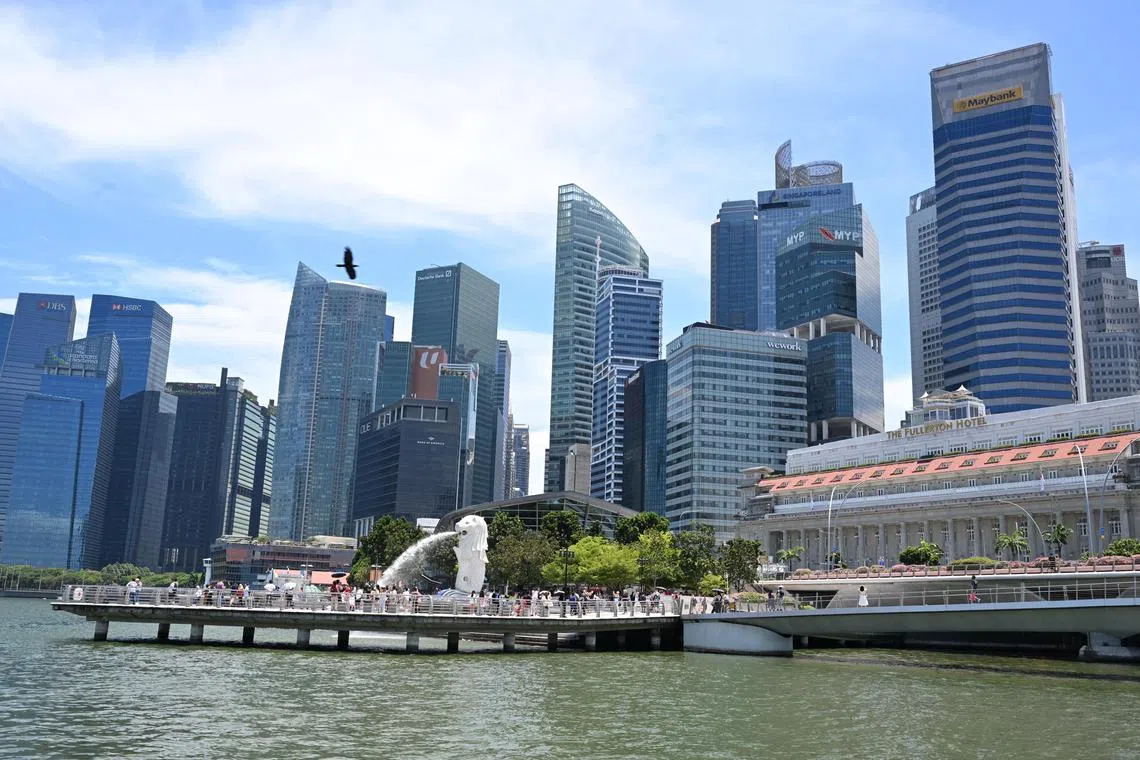Singapore raises 2025 economic growth forecast but warns of uncertainty from US tariffs
Sign up now: Get ST's newsletters delivered to your inbox

MTI warned that new tariffs could lead to a renewed spike in economic uncertainty, and cause businesses to suspend hiring and households to pull back on spending.
ST PHOTO: CHONG JUN LIANG
Follow topic:
SINGAPORE - Singapore raised its 2025 economic growth forecast on a better-than-expected performance in the first half of the year, but warned that the outlook remains clouded owing to US tariffs, with risks to the economy tilted to the downside.
The gross domestic product (GDP) growth forecast was raised to 1.5 per cent to 2.5 per cent, from an earlier range of 0 per cent to 2 per cent, the Ministry of Trade and Industry (MTI) said on Aug 12.
“This (upgrade) largely reflects the better-than-expected performance of the Singapore economy in the first half of 2025,” it said in a statement.
The move came after the economy posted a surprisingly high year-on-year growth of 4.4 per cent
On a seasonally adjusted quarterly basis, the Singapore economy expanded by 1.4 per cent in the second quarter, rebounding from the 0.5 per cent contraction in the first quarter.
MTI made the earlier forecast in April,
However, most tariff rates have been negotiated at much lower levels since then.
In the meantime, companies worldwide also rushed shipments to get ahead of the US tariffs. That resulted in an unseasonal surge in manufacturing and exports.
The phenomenon, known as front-loading, pushed Singapore’s key exports growth up by 5.2 per cent year on year in the first six months of the year – again much higher than the 1 per cent to 3 per cent range forecast by Enterprise Singapore.
MTI said GDP growth in the second quarter was primarily driven by export-oriented sectors such as wholesale trade, manufacturing, finance and insurance, and transportation and storage.
“The wholesale trade and transportation and storage sectors were boosted by front-loading activities in the region ahead of the implementation of tariff measures by the US,” said MTI.
On the other hand, domestic sectors such as food and beverage services shrank, owing in part to a sustained increase in outbound travel by locals.
“The performance of most advanced and regional economies has been more resilient than expected as the 90-day pause on US reciprocal tariffs postponed the potential negative economic impact, while front-loading activities during the tariff pause provided a temporary boost to production and exports,” said MTI.
There has also been a de-escalation in trade tensions, with the US striking trade deals with several trading partners,
The US and China continue to be engaged in trade talks, with the 90-day tariff truce between the two countries extended for another three months on Aug 11.
However, the Singapore economy is not likely to fare as well in the second half of 2025.
While it faces the lowest rate of 10 per cent tariffs, compared with much higher rates for most of its Asian peers, it still faces significant risk if Mr Trump decides to impose sectoral levies on its key exports, such as pharmaceuticals and semiconductors.
The trade-driven economy also suffers if its trading partners see lower economic growth.
Dr Beh Swan Gin, MTI’s permanent secretary, said: “The growth of Singapore’s major trading partners in the second half of 2025 is expected to moderate from that in the first half, as the boost from front-loading activities dissipates and US reciprocal tariffs take effect.”
At a press briefing on Aug 12, he said there are still lingering uncertainties, owing in part to the continued unpredictability of US trade policies.
“Against this backdrop, Singapore’s economic growth is expected to slow in the second half of the year compared with the first half because of slower growth in outward-oriented sectors,” he said.
MTI warned that new tariffs could lead to a renewed spike in economic uncertainty and cause businesses to suspend hiring and households to pull back on spending.
A shock to markets from worsening global financial conditions could lead to destabilising capital flows and trigger latent vulnerabilities in banking and financial systems.
Potential escalations in geopolitical tensions could lead to supply disruptions in energy commodities and renewed pressures on global energy prices.
Still, MTI pointed out, there are some bright spots within the economy, such as the transport engineering industry with its sustained shift towards higher value-added aircraft maintenance, repair and overhaul works.
Another is the precision engineering industry, which saw the continued ramp-up in capital investments by semiconductor manufacturers producing artificial intelligence-related chips.
Some analysts think MTI is still too cautious and Singapore’s economic growth may end up even higher than its upgraded forecast.
Bank of America’s Asean economist Ang Kai Wei said the lower end of MTI’s forecast “looks highly improbable”, as it implies the economy will shrink in the next two quarters.
Instead, a 2 per cent to 2.5 per cent range seems most probable now, he said.
However, Mr Barnabas Gan, group chief economist at RHB Bank, said MTI’s cautious approach was warranted pending a settled US tariff deal with China and India.
There was also uncertainty surrounding sectoral tariffs on pharmaceuticals and semiconductors, and the drag from fading export front-loading to contend with.
The economy’s outperformance in the first half of the year allowed the Monetary Authority of Singapore (MAS) to maintain its Singapore dollar policy stance at its July meeting, after back-to-back rounds of easing in January and April.
At the briefing, MAS chief economist Edward Robinson said the policy stance remains appropriate after accounting for factors affecting domestic growth and inflation.
“I would also add that a gradualist approach under conditions of uncertainty is useful as we update our assessment in a timely manner at our quarterly reviews,” he noted.
MAS, which uses the currency to manage inflation, will next update its policy stance in October.


